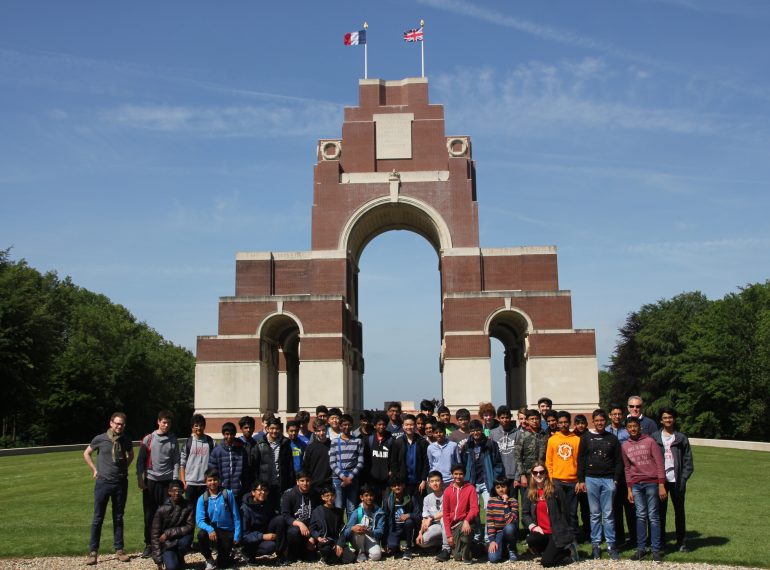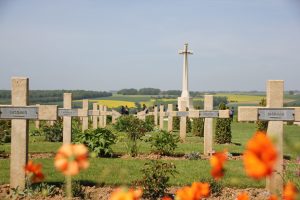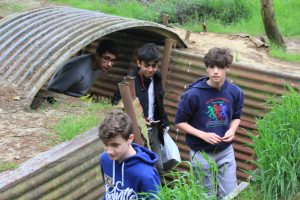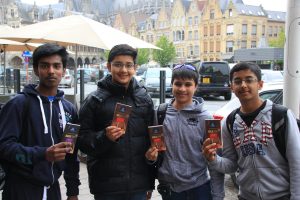
Forty-four Year 9 boys visited the major battle sites and cemeteries from World War I in a trip designed to reinforce their classroom History lessons on the conflict.
With plenty of opportunity to walk through preserved trenches just as this year’s poppies were starting to flower, the boys had time to reflect on life in the trenches. Some sites illustrated the global nature of the conflict, showing the role of countries from the British Empire and Commonwealth – particularly Canada and nearby Newfoundland.
 History teacher Simon Walker said: “The trip was important both emotionally and analytically, helping students understand how trench warfare worked and appreciate the experience of those who fought, as well as giving them an opportunity to reflect on the cost of war and consider what we can learn from the way soldiers have been memorialised.”
History teacher Simon Walker said: “The trip was important both emotionally and analytically, helping students understand how trench warfare worked and appreciate the experience of those who fought, as well as giving them an opportunity to reflect on the cost of war and consider what we can learn from the way soldiers have been memorialised.”
The trip aligned closely with the Year 9 scheme of work, which covers the changing nature of warfare up to 1945, with World War I a major topic.
On their visit to one site, Vimy Ridge, the guides for the QE boys and the four accompanying members of staff were students on a programme funded by the Canadian government, reflecting the national importance of the site in Canada.
 One striking contrast was seen in the ways the fallen were commemorated at:
One striking contrast was seen in the ways the fallen were commemorated at:
- Tyne Cot cemetery – the resting place of more than 11,900 servicemen of the British Empire at the battlefield of the Third Battle of Ypres (also known as the Battle of Passchendaele), where boys learned that many bodies could not be identified.
- Thiepval Memorial – commemorating 72,246 British and South African servicemen known to have died in the Battles of the Somme whose bodies could not be found.
- Essex Farm cemetery – a smaller Allied cemetery, with some moving examples of men from the ‘pals’ battalions’ who died on the same day being buried with their headstones touching to show solidarity between them.
- Beaumont-Hamel – the site of a memorial as well as trenches where Newfoundlanders fought during the Somme campaign; with 84% of the Royal Newfoundland Regiment battalion dying, the conflict brought devastation to some communities, depriving Newfoundland of most of its young men and seriously damaging its economy.
- The German Langemark cemetery – here, all graves are communal, with one huge mass grave in the middle and thousands of tiny names engraved on the stones around it. The headstones are very plan slabs laid flat on the ground, the relative lack of dignity in burial illustrating the hostility of Belgians towards Germans after the war. (The mass grave was partly because the Belgians would not grant the Germans enough land for individual burials.
 Other memorable highlights of the trip to the sites in France and Belgium included the sight of Lochnagar Crater, the biggest crater of World War I, where boys learned about tunnelling and the use of mines. They attended the Last Post ceremony at Menin Gate in Ypres to commemorate soldiers lost in the 1914–1918 – a ceremony performed every evening since 1927, even during World War II. They also learned how medical provision developed during the conflict, visiting a field hospital where John McCrae worked as a surgeon and composed his famous poem, In Flanders Fields.
Other memorable highlights of the trip to the sites in France and Belgium included the sight of Lochnagar Crater, the biggest crater of World War I, where boys learned about tunnelling and the use of mines. They attended the Last Post ceremony at Menin Gate in Ypres to commemorate soldiers lost in the 1914–1918 – a ceremony performed every evening since 1927, even during World War II. They also learned how medical provision developed during the conflict, visiting a field hospital where John McCrae worked as a surgeon and composed his famous poem, In Flanders Fields.
On the final day came visits to La Coupole and Blockhaus Bunker, which were sites for the production and launch of V1 and V2 rockets during World War II, where there was information on the role of concentration camp slave labour used by the Nazis. “These visits helped to develop students’ understanding of the changing nature of warfare in World War II, as well as providing a foundation for the space race and arms race topics that form an important part of the GSCE Conflict and Tension unit on the Cold War.
 There were lighter moments, too, including a popular visit to the Leonida chocolate shop and the time when the boys’ keen-eyed coach driver spotted a World War I wire fence post unearthed and left at the roadside by a local farmer.
There were lighter moments, too, including a popular visit to the Leonida chocolate shop and the time when the boys’ keen-eyed coach driver spotted a World War I wire fence post unearthed and left at the roadside by a local farmer.
Overall, said Mr Walker, the trip gave boys “an opportunity to deepen their understanding of the Year 9 theme about the changing nature of warfare, whilst also giving them personal experiences and time to reflect in order to help them develop and articulate their own emotional responses”. In addition, it supported understanding of the genocide topic being covered in the second half of term, and of GCSE topics including the Cold War and the Health and the People unit.



 Said to have first been used as a battle cry by Richard I as long ago as the 12th century, it remains in use to this day. But why, the boys wondered, was it so prominent at Hampton Court – a palace built more than 300 years after the words were first spoken? The Chapel Royal there has it written on the ceiling no fewer than 32 times!
Said to have first been used as a battle cry by Richard I as long ago as the 12th century, it remains in use to this day. But why, the boys wondered, was it so prominent at Hampton Court – a palace built more than 300 years after the words were first spoken? The Chapel Royal there has it written on the ceiling no fewer than 32 times!